© Copyright Atlanta Coin Expositions, 2008-2025. All Rights Reserved.
Several of the links on the pages within this web site go to affiliate vendors.
A vendor affiliation can mean a small monetary compensation to the web site owner at no additional cost to you.
Several of the links on the pages within this web site go to affiliate vendors.
A vendor affiliation can mean a small monetary compensation to the web site owner at no additional cost to you.
Coin Show
Information
Shop
General
Next Monthly Coin Show
Coin Show - Monthly Notes for July 2020
The July 2020 Greater Atlanta Coin Show, our second show after closing for COVID-19, enjoyed many visitors on a nice summer day to a bourse filled with dealers and collectibles.
Though not as many people as pre-COVID-19 shows, many guests came and kept the dealers busy with buying, selling, browsing and trading among the coins, currency, bullion and other collectibles.
Considering the circumstances, the show was very busy.
As such, we thank all of you for attending the show - dealers and guests, alike. We also appreciate our security and the hotel's staff for their support of the show.
Though not as many people as pre-COVID-19 shows, many guests came and kept the dealers busy with buying, selling, browsing and trading among the coins, currency, bullion and other collectibles.
Considering the circumstances, the show was very busy.
As such, we thank all of you for attending the show - dealers and guests, alike. We also appreciate our security and the hotel's staff for their support of the show.
The show wouldn't be a show without all of you, so thank you.
Once again, the hotel provided us with a larger space, which allowed for more social distancing among the dealers and between dealers and guests.
For a summer day in Hotlanta, the weather was certainly nice with highs in the 80s and mild humidity under mostly overcast skies. The early morning even had temperatures in the high 60s, much different from years past when the early morning mercury rose into the 90s.
Once again, the hotel provided us with a larger space, which allowed for more social distancing among the dealers and between dealers and guests.
For a summer day in Hotlanta, the weather was certainly nice with highs in the 80s and mild humidity under mostly overcast skies. The early morning even had temperatures in the high 60s, much different from years past when the early morning mercury rose into the 90s.
The hotel continues to operate but still with just a skeleton crew. We were the only event on our Sunday in July. We hope they see more events occurring soon.
This month, there were more vehicles in the hotel's parking lot. Maybe they had more guests staying overnight.
During the day, we did notice some ASPCA vans near the hotel - not sure if they were doing rescue or some other activity.
As for the interest on the bourse, there's always someone looking at gold and silver coins, both old and new. Now, it seems with the tariffs applied to Chinese imports, the panda coins have increased in price over comparable gold and silver coins from other countries, including the USA.
Just a thought, you may want to consider other types of gold and silver unless you have your heart set on a panda coin.
Now, let's take a look at a small sampling of the coins seen on the bourse:
This month, there were more vehicles in the hotel's parking lot. Maybe they had more guests staying overnight.
During the day, we did notice some ASPCA vans near the hotel - not sure if they were doing rescue or some other activity.
As for the interest on the bourse, there's always someone looking at gold and silver coins, both old and new. Now, it seems with the tariffs applied to Chinese imports, the panda coins have increased in price over comparable gold and silver coins from other countries, including the USA.
Just a thought, you may want to consider other types of gold and silver unless you have your heart set on a panda coin.
Now, let's take a look at a small sampling of the coins seen on the bourse:
1825 Capped Bust Silver Half Dollar Coin
Our first coin is a Capped Bust Silver Half Dollar Coin produced by the US Mint in Philadelphia.
The Mint produced the Capped Bust Lettered Edge Half Dollar Coins during the years of 1807 through 1836.
For this version, they struck just over 2.9 million of the 1825 half dollars.
A German immigrant, John Reich, an engraver for the Mint, designed both the obverse and reverse of the coins with a capped bust of Liberty on the front, an eagle with shield on the back and a lettered edge specifying the denomination.
Of interest, Mr. Reich arrived in America under a bond of servitude, however he became an engraver for the Mint after an official freed him from the bond.
He was also the first designer to include the denomination on all of his coin designs.
This early coin consisted of mostly silver with a small amount of copper, 10.76%, added for stability.
The Mint produced the Capped Bust Lettered Edge Half Dollar Coins during the years of 1807 through 1836.
For this version, they struck just over 2.9 million of the 1825 half dollars.
A German immigrant, John Reich, an engraver for the Mint, designed both the obverse and reverse of the coins with a capped bust of Liberty on the front, an eagle with shield on the back and a lettered edge specifying the denomination.
Of interest, Mr. Reich arrived in America under a bond of servitude, however he became an engraver for the Mint after an official freed him from the bond.
He was also the first designer to include the denomination on all of his coin designs.
This early coin consisted of mostly silver with a small amount of copper, 10.76%, added for stability.
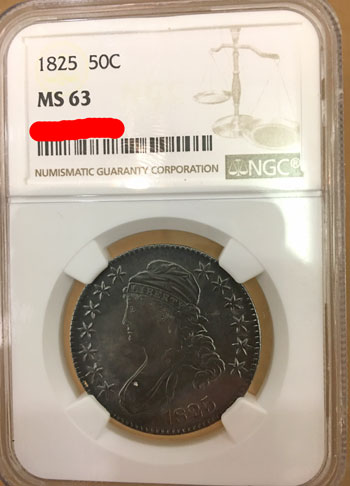
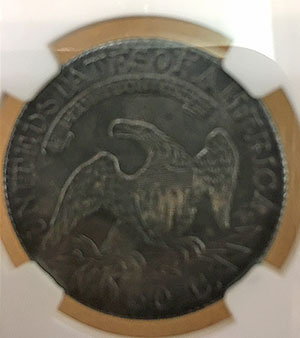
"Mint State survivors are plentiful in relation to most earlier dates, and a fair number of gems have been certified.
"Slight changes in the bust of Liberty reflect a new obverse master punch, and this appears to have been among the first efforts of William Kneass. Appointed Chief Engraver the year before, succeeding the late Robert Scot, Kneass would go on to modify most denominations over the next several years."
In total, NGC has graded 1436 of the 1825 half dollars with 80 of them as MS63 and with 97 in higher grades.
In other words, this is a nice specimen of a 195-year old coin.
"Slight changes in the bust of Liberty reflect a new obverse master punch, and this appears to have been among the first efforts of William Kneass. Appointed Chief Engraver the year before, succeeding the late Robert Scot, Kneass would go on to modify most denominations over the next several years."
In total, NGC has graded 1436 of the 1825 half dollars with 80 of them as MS63 and with 97 in higher grades.
In other words, this is a nice specimen of a 195-year old coin.
The Official ANA Grading Standards commented about the Capped Bust production, "Coins minted prior to 1836 often show minor weaknesses or friction spots even though they might never have been used in circulation. Such coins are difficult to distinguish and are sometimes considered to be Mint State (MS) rather than About Uncirculated (AU), when they have superior eye appeal, strike or appearance."
They described the MS63 for this coin as "A Mint State coin with attractive mint luster, but noticeable detracting contact marks or minor blemishes."
In the NGC's (Numismatic Guaranty Corporation) description of the 1825 half dollar, they noted:
"This was yet another year of large half dollar mintages, requiring 15 obverse dies and 16 reverses. These were used in a total of 18 combinations, of which Overton-118 is extremely rare. The only use of Obverse 15, this die cracked severely, and that most likely accounts for its early retirement. O-109 is very scarce, but all the others range from common to just slightly scarce.
They described the MS63 for this coin as "A Mint State coin with attractive mint luster, but noticeable detracting contact marks or minor blemishes."
In the NGC's (Numismatic Guaranty Corporation) description of the 1825 half dollar, they noted:
"This was yet another year of large half dollar mintages, requiring 15 obverse dies and 16 reverses. These were used in a total of 18 combinations, of which Overton-118 is extremely rare. The only use of Obverse 15, this die cracked severely, and that most likely accounts for its early retirement. O-109 is very scarce, but all the others range from common to just slightly scarce.
1870 Seated Liberty Silver Half Dollar Coin
Still in the same family, the next coin is an 1870 Seated Liberty Silver Half Dollar Coin.
Christian Gobrecht designed the Seated Liberty coins, which includeed Liberty holding a staff with a Phyrgian cap in her left hand and a shield with LIBERTY on her right leaning against her leg on the obverse. The reverse design had an eagle with a shield and holding the olive branch and arrows in its talons.
Per the Red Book, the US Mint produced five different varieties of the Seated Liberty half dollar coins during 1839-1891. The varieties included changes in the design and also different weights.
When they began making proof half dollars in 1858, only the Philadelphia location produced the proof coins. For the circulation strikes, Philadelphia produced the coins every year, but they also utilized the New Orleans, Carson City and San Francisco mint locations during some of the years.
The weight began as 13.36 grams of 90% silver and 10% copper. They reduced the weight to 12.44 grams for the varieties in 1853, 1854 and 1855.
Christian Gobrecht designed the Seated Liberty coins, which includeed Liberty holding a staff with a Phyrgian cap in her left hand and a shield with LIBERTY on her right leaning against her leg on the obverse. The reverse design had an eagle with a shield and holding the olive branch and arrows in its talons.
Per the Red Book, the US Mint produced five different varieties of the Seated Liberty half dollar coins during 1839-1891. The varieties included changes in the design and also different weights.
When they began making proof half dollars in 1858, only the Philadelphia location produced the proof coins. For the circulation strikes, Philadelphia produced the coins every year, but they also utilized the New Orleans, Carson City and San Francisco mint locations during some of the years.
The weight began as 13.36 grams of 90% silver and 10% copper. They reduced the weight to 12.44 grams for the varieties in 1853, 1854 and 1855.
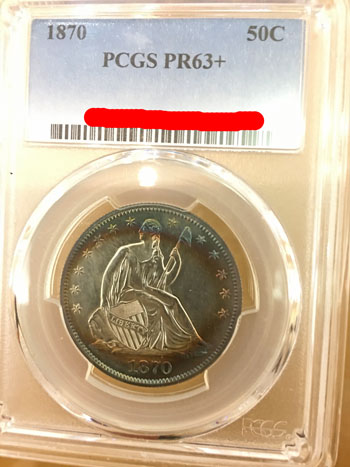
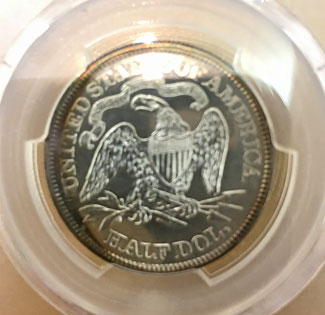
As a Variety 4, the 1870 Seated Half Dollar Coin weighed 13.36 grams and included the IN GOD WE TRUST motto on a ribbon above the eagle on the reverse.
PCGS (Professional Coin Grading Services) graded this coin as a PR63+, one of 1000 produced in 1870.
As a side note, PCGS shows six different varieties with the 1870 being a Variety 5.
They noted:
"In 1870, production of Proof Half Dollars jumped from 600 to 1,000 coins, presumably because of increased collector demand. Even with the larger mintage, however, the number of survivors of this date is not very much higher than that of the 1869 Half Dollar.
PCGS (Professional Coin Grading Services) graded this coin as a PR63+, one of 1000 produced in 1870.
As a side note, PCGS shows six different varieties with the 1870 being a Variety 5.
They noted:
"In 1870, production of Proof Half Dollars jumped from 600 to 1,000 coins, presumably because of increased collector demand. Even with the larger mintage, however, the number of survivors of this date is not very much higher than that of the 1869 Half Dollar.
"The grade distribution of Proof 1870 Half Dollars mirrors that of 1869, meaning that the most frequently-seen grade is PR64. Cameo Proof 1870 Half Dollars are very, very rare -- much more so than in previous years.
"This makes the odds very small that a Deep Cameo Proof 1870 Half Dollar will ever appear on the market (PCGS has not yet graded one as on 5/2018)."
In 2020, however, their statistics show they have now graded seven as proof cameo coins.
As a PR63+, PCGS rated this coin better than a 63 but less than a 64.
They describe a 63 grade as "Average of slightly weak strike with moderate marks or hairlines.
"This makes the odds very small that a Deep Cameo Proof 1870 Half Dollar will ever appear on the market (PCGS has not yet graded one as on 5/2018)."
In 2020, however, their statistics show they have now graded seven as proof cameo coins.
As a PR63+, PCGS rated this coin better than a 63 but less than a 64.
They describe a 63 grade as "Average of slightly weak strike with moderate marks or hairlines.
Similarly, for a 64 grade, they comment, "Average or better strike with scattered marks or hairlines, though none severe."
Of course, this specimen showcases the Seated Liberty design and has interesting toning that highlights the features of the coin.
A nice example, indeed.
Of course, this specimen showcases the Seated Liberty design and has interesting toning that highlights the features of the coin.
A nice example, indeed.
1893-s Morgan Silver Dollar Coin F12
The next two coins are different grades of the same year and the same mint production. They represent one of the favorite silver dollar coins, the Morgan Dollar.
The San Francisco Mint produced just over 8.2 million of these silver dollars.
PCGS graded this first one as a F12 coin.
The ANA Grading Standards described the F12 grade as:
"Obverse: Hair line along face is clearly defined. Lower two cotton leaves are smooth but distinct from cap. Some wheat grains merge. Cotton bolls are flat, but the two lines in each show clearly.
"Reverse: One-quarter of eagle's right wing and edge of left wing are smooth. Head, neck, and breast are flat and merge. Tail feathers are slightly worn. Top leaves in wreath show heavy wear."
On the PCGS web site, David Hall commented about the 1893-S Morgan Dollar:
The San Francisco Mint produced just over 8.2 million of these silver dollars.
PCGS graded this first one as a F12 coin.
The ANA Grading Standards described the F12 grade as:
"Obverse: Hair line along face is clearly defined. Lower two cotton leaves are smooth but distinct from cap. Some wheat grains merge. Cotton bolls are flat, but the two lines in each show clearly.
"Reverse: One-quarter of eagle's right wing and edge of left wing are smooth. Head, neck, and breast are flat and merge. Tail feathers are slightly worn. Top leaves in wreath show heavy wear."
On the PCGS web site, David Hall commented about the 1893-S Morgan Dollar:
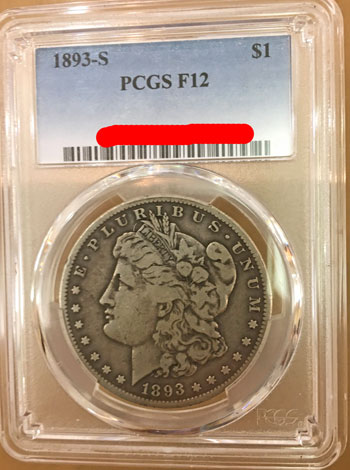
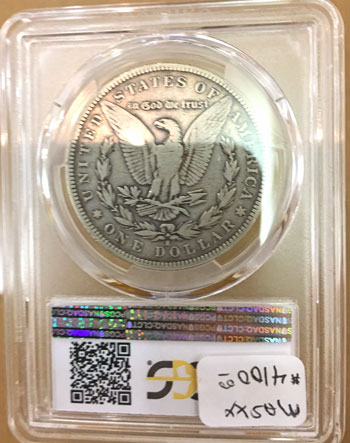
"The 1893-S is the true 'King' of the Morgan dollar series. The PCGS CoinFacts Board of experts estimated survival number for all grades is 9948. Dave Bowers has estimated that 6000 to 12,000 survive and I think those numbers are probably accurate. There are probably as many as 10,000 1893-S dollars in all grades.
"In Mint State condition, the 1893-S is absolutely the rarest Morgan dollar. And in Gem MS65 or better it's a super rare coin. I believe the true number of MS65 or better examples is probably 6 to 7 coins.
"Note that this is one Morgan that is virtually unknown in prooflike condition.
"Note that there are many counterfeits, usually made by adding an 'S' to a 1893 Philadelphia. So authentication is highly recommended."
In other words, even graded as F12, this is a rare Morgan Dollar minted in San Francisco.
"In Mint State condition, the 1893-S is absolutely the rarest Morgan dollar. And in Gem MS65 or better it's a super rare coin. I believe the true number of MS65 or better examples is probably 6 to 7 coins.
"Note that this is one Morgan that is virtually unknown in prooflike condition.
"Note that there are many counterfeits, usually made by adding an 'S' to a 1893 Philadelphia. So authentication is highly recommended."
In other words, even graded as F12, this is a rare Morgan Dollar minted in San Francisco.
1893-s Morgan Silver Dollar Coin VF 20
"Obverse: Smooth spots are visible on hair from forehead to ear. Cotton leaves are heavily worn but separated. Wheat grains show wear.
"Reverse: Some leaves on wreath are well worn. Breast is smooth, and only a few feathers show on head. Tips of wings are weak, but lines are complete.
Similar to the earlier description, NGC notes on their web site for the 1893-S Morgan Dollar Coin:
"The 1893-S Morgan dollar is the undisputed king of the entire series. It has the lowest mintage of any issue, at only 100,000 coins. Additionally, most of the tiny mintage was desperately needed in circulation, meaning few survived in mint state.
"At NGC, the majority of examples are in the XF or lower range. However, the most commonly seen uncirculated grade at NGC is MS64 with 10 pieces, although it is likely many of those are from resubmissions hoping for the nearly impossible to obtain gem grade. (9/2016)
"Reverse: Some leaves on wreath are well worn. Breast is smooth, and only a few feathers show on head. Tips of wings are weak, but lines are complete.
Similar to the earlier description, NGC notes on their web site for the 1893-S Morgan Dollar Coin:
"The 1893-S Morgan dollar is the undisputed king of the entire series. It has the lowest mintage of any issue, at only 100,000 coins. Additionally, most of the tiny mintage was desperately needed in circulation, meaning few survived in mint state.
"At NGC, the majority of examples are in the XF or lower range. However, the most commonly seen uncirculated grade at NGC is MS64 with 10 pieces, although it is likely many of those are from resubmissions hoping for the nearly impossible to obtain gem grade. (9/2016)
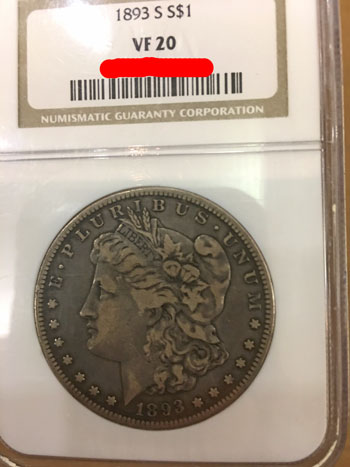
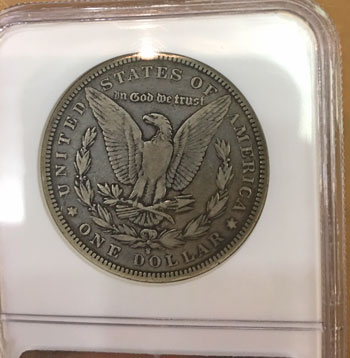
"Note: This coin is commonly targeted by counterfeiters."
George T. Morgan, once a student at the Royal Mint in London, designed the popular Morgan Dollar and added the initial "M" to both the obverse and reverse designs.
The silver dollar weighed at 26.73 grams and contained 90% silver and 10% copper. The overall silver content in the coin weighed at .777344 ounce.
Of course, the Morgan Dollar Coins are popular with silver enthusiasts as an investment due to its size and weight.
But, many just like the overall design of the coin.
Either way, this is another nice specimen of the rare1893-S Morgan Silver Dollar Coin.
George T. Morgan, once a student at the Royal Mint in London, designed the popular Morgan Dollar and added the initial "M" to both the obverse and reverse designs.
The silver dollar weighed at 26.73 grams and contained 90% silver and 10% copper. The overall silver content in the coin weighed at .777344 ounce.
Of course, the Morgan Dollar Coins are popular with silver enthusiasts as an investment due to its size and weight.
But, many just like the overall design of the coin.
Either way, this is another nice specimen of the rare1893-S Morgan Silver Dollar Coin.
NGC graded the next example of the 1893-S Morgan Dollar Coin as a VF20.
The ANA Grading Standards listed the VF20 grade as:
The ANA Grading Standards listed the VF20 grade as:
1922 Grant Star Commemorative Silver Half Dollar Coin
"Ulysses S. Grant was the 18th President of the United States and was also a decorated Civil War general who helped turn the tide of the war in favor of the Union.
"In 1921, a group arose calling themselves the Ulysses S. Grant Centenary Association. This organization’s goal was to coordinate special observances and create monuments in recognition of Grant’s impact on the country.
"To finance these ventures, the group sought the minting of up to 200,000 gold dollars. The bill was eventually emended to call for only 10,000 gold dollars, but also up to 250,000 half dollars. This amended legislation was passed on February 2, 1922.
"The preparation of designs was entrusted to Laura Gardin Fraser, wife of James Earle Fraser, the artist who had fashioned the Buffalo nickel. Mrs. Fraser was an accomplished medalist in her own right, having won acclaim already for her work on the Alabama Centennial half dollar of 1921.
"Her design was used on both the gold and silver Grant coins. The obverse features a right-facing portrait of the general, with UNITED STATES OF AMERICA around the upper rim, HALF DOLLAR at the bottom, ULYSSES S. GRANT to the left and right of the portrait and the double dates 1822-1922 below it.
"In 1921, a group arose calling themselves the Ulysses S. Grant Centenary Association. This organization’s goal was to coordinate special observances and create monuments in recognition of Grant’s impact on the country.
"To finance these ventures, the group sought the minting of up to 200,000 gold dollars. The bill was eventually emended to call for only 10,000 gold dollars, but also up to 250,000 half dollars. This amended legislation was passed on February 2, 1922.
"The preparation of designs was entrusted to Laura Gardin Fraser, wife of James Earle Fraser, the artist who had fashioned the Buffalo nickel. Mrs. Fraser was an accomplished medalist in her own right, having won acclaim already for her work on the Alabama Centennial half dollar of 1921.
"Her design was used on both the gold and silver Grant coins. The obverse features a right-facing portrait of the general, with UNITED STATES OF AMERICA around the upper rim, HALF DOLLAR at the bottom, ULYSSES S. GRANT to the left and right of the portrait and the double dates 1822-1922 below it.
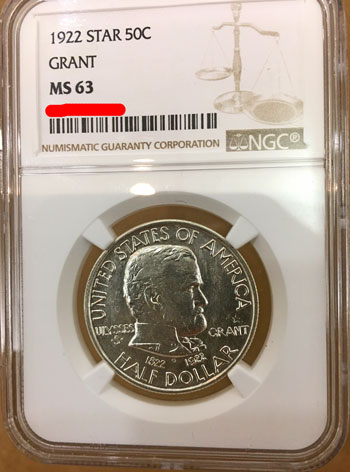
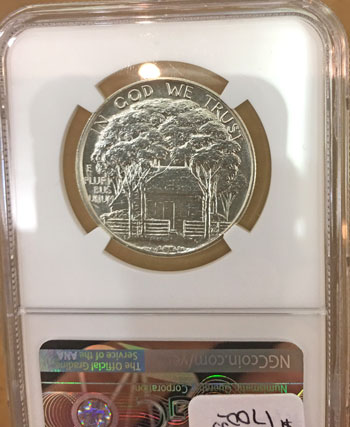
Our next coin is another half dollar, this time a silver commemorative half dollar coin remembering President Grant and his home place as a child.
NGC graded this coin as MS63.
On their web site, they provide a detailed description of the design and of the star significance:
NGC graded this coin as MS63.
On their web site, they provide a detailed description of the design and of the star significance:
"The reverse shows the fenced-in clapboard house where Grant lived as a boy, shaded by a canopy of trees. IN GOD WE TRUST appears above and E PLURIBUS UNUM is broken into four lines to the left. The designer's initial G (for her maiden name, Gardin) appears below Grant’s bust, between the double dates.
"The sponsors of the Missouri and Alabama commemoratives placed special markings on a small number of their respective commemoratives to increase sales. Apparently the Grant Centenary Association liked this idea and decided that they too would add an additional marking to some of their coins.
"The only difference between the normal issue Grant halves and the variety is the addition of a small star above the name GRANT on the obverse. This was done to half of the gold dollars, and due to a mix-up at the mint, was actually put on 5,000 of the half dollars as well.
"The sponsors of the Missouri and Alabama commemoratives placed special markings on a small number of their respective commemoratives to increase sales. Apparently the Grant Centenary Association liked this idea and decided that they too would add an additional marking to some of their coins.
"The only difference between the normal issue Grant halves and the variety is the addition of a small star above the name GRANT on the obverse. This was done to half of the gold dollars, and due to a mix-up at the mint, was actually put on 5,000 of the half dollars as well.
"Eventually 750 of those were melted, leaving only 4,250 Grant Star halves. 27,650 of the non-star Grant halves were melted, leaving a net mintage of 67,350. Both the star and non-star issues of the gold dollar sold out, resulting in net mintages of 5,000 pieces each."
At MS63, this coin provides a worthy representation of the remaining star Grant Commemorative Silver Half Dollar Coins.
At MS63, this coin provides a worthy representation of the remaining star Grant Commemorative Silver Half Dollar Coins.
1928 Hawaiian Commemorative Silver Half Dollar Coin
In general, the ANA Grading Standards described MS64 as:
"Has at least average luster and strike for the type. Several small contact marks in groups, as well as one or two moderately heavy marks may be present. One or two small patches of hairlines may show. Noticeable light scuff marks or defects might be seen within the design or in the field. Overall quality is attractive, with a pleasing eye appeal."
On the PCGS web site, David Hall commented:
"The Hawaiian commemorative half dollar, struck to commemorate the sesquicentennial (150th anniversary) of Captain Cook's landing in the Hawaiian Islands in 1778, was a rousing success.
"Unlike many other silver commemoratives, especially those struck in the 'abusive' commemorative era of 1935-1939, the Hawaiian was a legitimate anniversary, a relatively low mintage coin, and an 'honestly' distributed issue.
"Has at least average luster and strike for the type. Several small contact marks in groups, as well as one or two moderately heavy marks may be present. One or two small patches of hairlines may show. Noticeable light scuff marks or defects might be seen within the design or in the field. Overall quality is attractive, with a pleasing eye appeal."
On the PCGS web site, David Hall commented:
"The Hawaiian commemorative half dollar, struck to commemorate the sesquicentennial (150th anniversary) of Captain Cook's landing in the Hawaiian Islands in 1778, was a rousing success.
"Unlike many other silver commemoratives, especially those struck in the 'abusive' commemorative era of 1935-1939, the Hawaiian was a legitimate anniversary, a relatively low mintage coin, and an 'honestly' distributed issue.
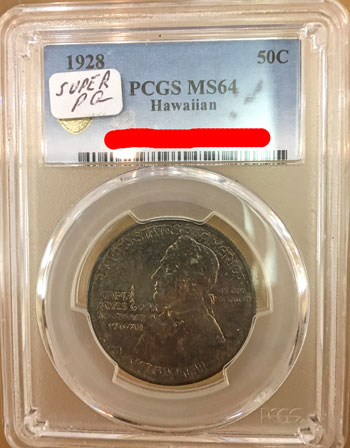
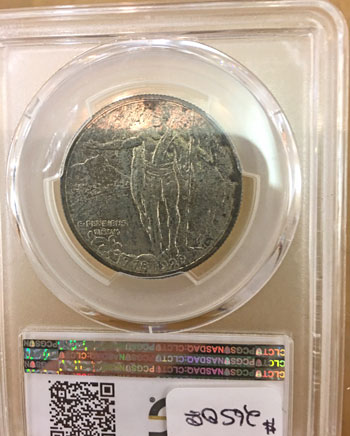
The next coin, another commemorative, recognized a milestone for Hawaii.
PCGS graded this example as MS64.
PCGS graded this example as MS64.
"The Hawaiian halves were sold at an issue price of $2 by the Bank of Hawaii. The original 10,008 coins minted sold out immediately, even though the $2 issue price was the highest of any commemorative half dollar to that point.
"The Hawaiian half dollars were widely distributed and, because of their relatively low type mintage and earlier issue date, they are somewhat rare today.
"They have always been considered a key issue to the silver commemorative series and they have always had good collector demand.
"The typical Hawaiian is well-struck and relatively mark-free.
"Toning can be an issue with Hawaiian halves so eye appeal is very important. Most Hawaiians have semi-frosty/semi-satin luster. But many are toned to various degrees, some quite attractively, but some pretty dark and dingy. Again, eye appeal is critical with this issue.
"Note that 50 examples were struck as matte-proofs."
"The Hawaiian half dollars were widely distributed and, because of their relatively low type mintage and earlier issue date, they are somewhat rare today.
"They have always been considered a key issue to the silver commemorative series and they have always had good collector demand.
"The typical Hawaiian is well-struck and relatively mark-free.
"Toning can be an issue with Hawaiian halves so eye appeal is very important. Most Hawaiians have semi-frosty/semi-satin luster. But many are toned to various degrees, some quite attractively, but some pretty dark and dingy. Again, eye appeal is critical with this issue.
"Note that 50 examples were struck as matte-proofs."
This coin may be one of the darker toned examples, but it's still a pleasing portrayal of the limited number of Hawaiian Sesquicentennial Commemorative Silver Half Dollar Coins.
1971 Eisenhower Dollar Coin - Type 1 and Type 2 Paired Set
Now, here's the interesting part.
Take a look in the Red Book or online with NCG and PCGS. They do not show information about Type 1 proof coins.
From the Red Book:
"After 1971, the dies for the Eisenhower dollar were modified several times by changing the relief, strengthening the design, and making Earth above the eagle more clearly defined.
"Low-relief (Variety I) dies, with flattened Earth and three islands off Florida, were used for all copper-nickel issues of 1971, Uncirculated silver coins of 1971, and most copper-nickel coins of 1972.
Take a look in the Red Book or online with NCG and PCGS. They do not show information about Type 1 proof coins.
From the Red Book:
"After 1971, the dies for the Eisenhower dollar were modified several times by changing the relief, strengthening the design, and making Earth above the eagle more clearly defined.
"Low-relief (Variety I) dies, with flattened Earth and three islands off Florida, were used for all copper-nickel issues of 1971, Uncirculated silver coins of 1971, and most copper-nickel coins of 1972.
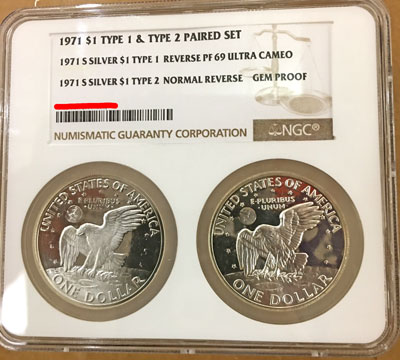
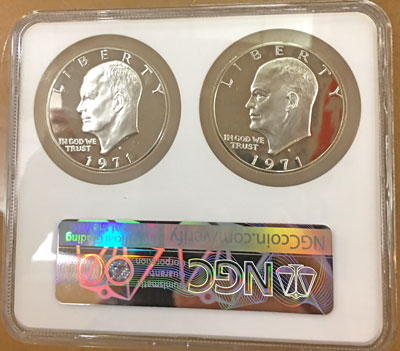
Our last example for this month is interesting.
It's a two-coin paired set graded by NGC.
The two coins showcase the Type 1 and Type 2 versions of the 1971 Eisenhower Dollar Coin.
Both of the coins are silver and minted in San Francisco. One is graded PF69 Ultra Cameo while the other is a Gem Proof grade.
It's a two-coin paired set graded by NGC.
The two coins showcase the Type 1 and Type 2 versions of the 1971 Eisenhower Dollar Coin.
Both of the coins are silver and minted in San Francisco. One is graded PF69 Ultra Cameo while the other is a Gem Proof grade.
"High-relief (Variety II) dies, with round Earth and weak or indistinct islands, were used for most Proofs of 1971, all silver issues of 1972, and the reverse of some scarce Philadelphia copper-nickel coins of 1972.
"Improved high-relief reverse dies (Variety III) were used for late-1972 Philadelphia copper-nickel coins and for all subsequent issues.
"Improved high-relief reverse dies (Variety III) were used for late-1972 Philadelphia copper-nickel coins and for all subsequent issues.
"Modified high-relief dies were also used on all issues beginning in 1973."
Reading through their description, there is no mention of 1971 Silver Proof Type 1 (Variety I) Eisenhower Dollar Coins.
However, some leeway is given in their comment about "most" 1971 proofs being Type 2 (Variety II).
"Most" implies the Mint produced some 1971 proofs that were not Type 2 (Variety II).
Supposedly, there are few as in less than five known Type 1 Proof Silver Eisenhower Dollar Coins, and this set includes one of those.
Just goes to show that interesting coins can occur in any era and in any denomination.
Reading through their description, there is no mention of 1971 Silver Proof Type 1 (Variety I) Eisenhower Dollar Coins.
However, some leeway is given in their comment about "most" 1971 proofs being Type 2 (Variety II).
"Most" implies the Mint produced some 1971 proofs that were not Type 2 (Variety II).
Supposedly, there are few as in less than five known Type 1 Proof Silver Eisenhower Dollar Coins, and this set includes one of those.
Just goes to show that interesting coins can occur in any era and in any denomination.
Our August 2020 Greater Atlanta Coin Show is still scheduled and will occur unless state, county, local, hotel or other issues prevent the show.
The dealers will fill the bourse and display their collectibles including coins, currency, bullion, exonumia, scripophily, semi-precious stones, jewelry and other intriguing items.
Many of our regular dealers will be there as well as a few visiting dealers filling in for several who don't want to set-up at a show just yet.
Whether you are an experienced collector or investor or someone new to a coin show, there will be knowledgeable dealers that can help you with your search.
The dealers will fill the bourse and display their collectibles including coins, currency, bullion, exonumia, scripophily, semi-precious stones, jewelry and other intriguing items.
Many of our regular dealers will be there as well as a few visiting dealers filling in for several who don't want to set-up at a show just yet.
Whether you are an experienced collector or investor or someone new to a coin show, there will be knowledgeable dealers that can help you with your search.
All visitors to the show are welcome whether buying, selling, trading or just looking at the many different items.
Visitors may also bring items to the show for a free verbal appraisal, and if desired, offer to sell those collectibles to one or more dealers at the show.
Mark your calendar and visit the next Greater Atlanta Coin Show on Sunday, August 9, 2020 in the Joe Mack Wilson ballroom to buy, sell, trade or just browse among the many items on display.
Visitors may also bring items to the show for a free verbal appraisal, and if desired, offer to sell those collectibles to one or more dealers at the show.
Mark your calendar and visit the next Greater Atlanta Coin Show on Sunday, August 9, 2020 in the Joe Mack Wilson ballroom to buy, sell, trade or just browse among the many items on display.
